Delicious and full of health benefits, green tea is one of the most consumed beverages in the world. Green tea is comprised of leaves of the camellia sinensis plant. Green tea is known for its natural catechin content, with antioxidants that fight cell damage when ingested. Studies also suggest that green tea may lower cholesterol and prevent various forms of cancer. Because of its possible health benefits, green tea has become a popular ingredient for bath and beauty products.
These Exfoliating Green Tea Cold Process Bars are made with green tea rather than water. In addition, green tea extract is also added to harness its skin-loving properties. Scented with Green Tea Fragrance Oil, this soap smells fresh, clean and perfect for both men and women. Half of these bars include jojoba beads, which offer gentle exfoliation.
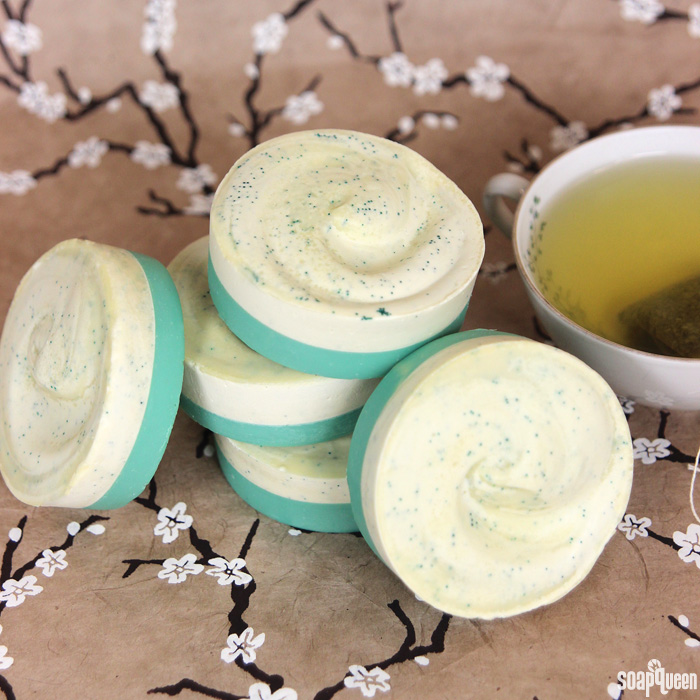
Most cold process recipes on Soap Queen are formulated at 5% superfat. Superfat refers to the percentage of oil that is not turned into soap by the lye. Click here to see a visual representation of the saponification process, along with the concept of superfat. In my experience, I find that a 5% superfat is extremely skin-loving, while still firm and easy to unmold. Because of the extra oil in the green tea extract and colorants, I decreased the superfat to 3% in this recipe to aid in unmolding. Keep in mind that a 0% superfat is a perfectly balanced bar of soap! Less than 5% superfat is not a dangerous or bad thing. =)
What You’ll Need:
12 Bar Round Silicone Mold
1.8 oz. Avocado Butter
2.5 oz. Canola Oil
1 oz. Castor Oil
8.8 oz. Coconut Oil
5.3 oz. Green Tea Seed Oil
7 oz. Olive Oil
8.8 oz. Palm Oil
5 oz. Sodium Hydroxide Lye
11.6 oz. Distilled Water
Hydrated Chrome Green Oxide
Titanium Dioxide
Forest Green Jojoba Beads
2.5 oz. Green Tea Fragrance Oil
1 Tbs. Green Tea Extract
Optional: Green tea for the lye water
 Click here to add everything you need for this project to your Bramble Berry shopping cart!
Click here to add everything you need for this project to your Bramble Berry shopping cart!
If you’ve never made Cold Process soap before, stop here! I highly recommend checking out our FREE four part SoapQueen.tv series on Cold Process Soapmaking, especially the episode on lye safety. And if you’d rather do some reading, Bramble Berry carries a wide range of books on the topic, including my newest book, Soap Crafting. You can also checkout the digital downloads for that instant gratification factor.
SAFETY FIRST: Suit up for safe handling practices! That means goggles, gloves and long sleeves. Make sure kids, pets, and other distractions and tripping hazards are out of the house or don’t have access to your soaping space. Always soap in a well-ventilated area.
COLOR PREP: To ensure that the Titanium Dioxide blends smoothly into the soap batter, we recommend micronizing it before dispersing it in oil. Please note this is an optional tip but it does help with the titanium dioxide clumping in the soap =) To micronize colorant, simply use a coffee grinder to blend the colorant to break up any clumps of color and prevent streaks of white from showing in the final soap. We like to use a coffee grinder that has a removable, stainless steel mixing area for easy cleaning. Then, disperse 1 teaspoon of the colorant into 1 tablespoon of sunflower or sweet almond oil (or any other liquid oil). Disperse 1 teaspoon Hydrated Chrome Green Oxide into 1 tablespoon lightweight liquid oil. Use a mini mixer to work out any clumps.
GREEN TEA PREP: When adding lye to an alternative liquid such as green tea, the natural sugars in the liquid will burn, causing the liquid to become a dark color. To help keep temperatures down, it’s best to chill the tea before adding the lye. First, boil distilled water to prepare the tea. Measure 11.6 of the hot water into a heat safe container, and add your green tea. Any band of green tea is fine, just make sure there are no added sugars. Allow the tea to steep and cool for about 1 hour. Remove the tea bags and place in the freezer until the liquid reaches about 40 ° F. The cooler the mixture, the lighter the color of the lye mixture will be. If you’d like, you can also freeze the green tea and add the lye to the frozen tea, similar to adding lye to milk, as shown here.
ONE: Slowly and carefully add the lye to the green tea water and gently stir until the lye has fully dissolved. The mixture will be a brown color. (Do not panic. It does harden up way lighter and that’s what the titanium dioxide is for.) Set aside to cool.
TWO: Fully melt the coconut, olive, avocado butter, canola, castor, green tea seed and palm oils (remember to fully melt then mix your entire container of palm oil before portioning). Once the lye water and the oils have cooled to 130 degrees or below (and are ideally within 10 degrees of each other), add the lye water to the oils and stick blend until thin trace. If you’d like a harder bar of soap that releases faster from the mold, you can add sodium lactate to the cooled lye water. Use 1 teaspoon of sodium lactate per pound of oils in the recipe. For this recipe, you’d add about 2 tsp. sodium lactate.
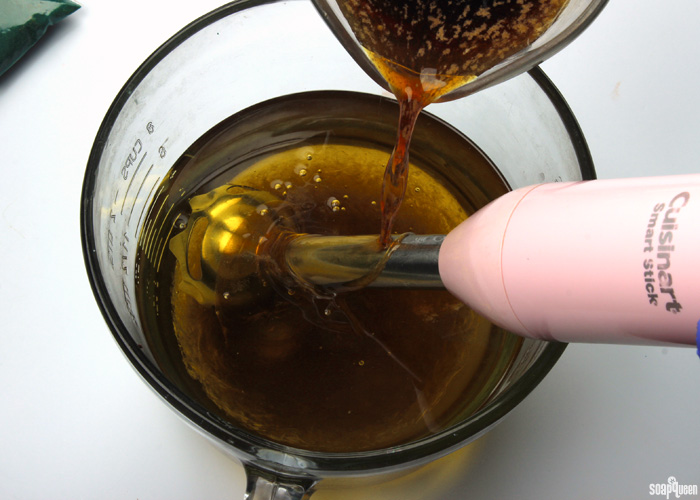
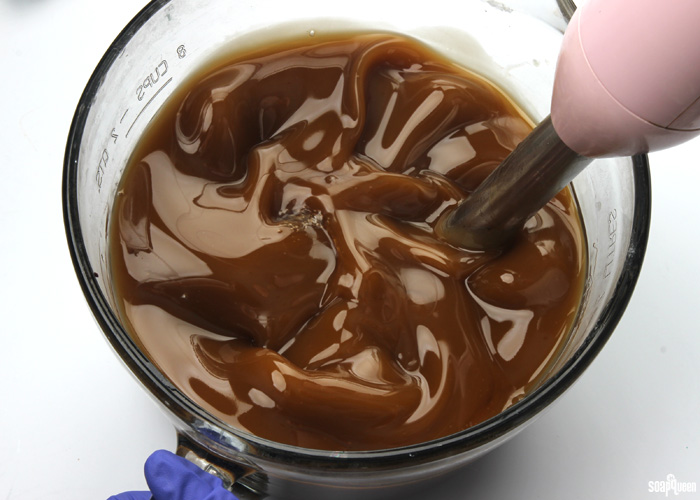
THREE: Once the batter has reached a light trace, add 1 tablespoon Green Tea Extract and stick blend to fully incorporate.
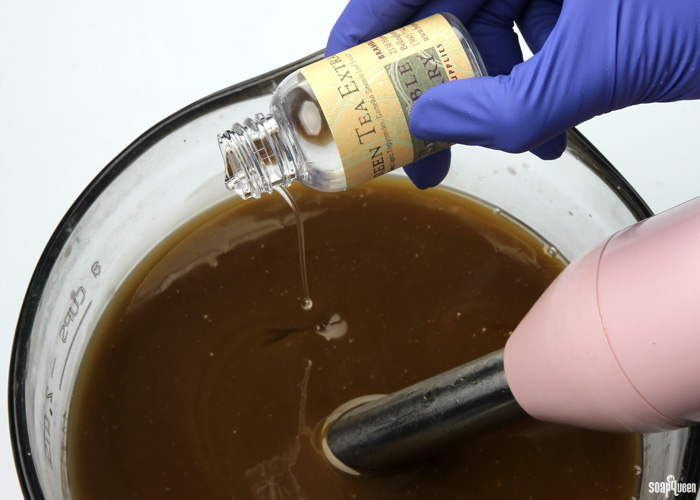
FOUR: Add 1 tablespoon dispersed Titanium Dioxide to the entire mixture. Use the stick blender to mix in the colorant, alternating between pulsing and stirring with the blender. As you stick blend, the color will become lighter but will still be a tan color. Don’t worry! The color will continue to lighten as it hardens in the mold.
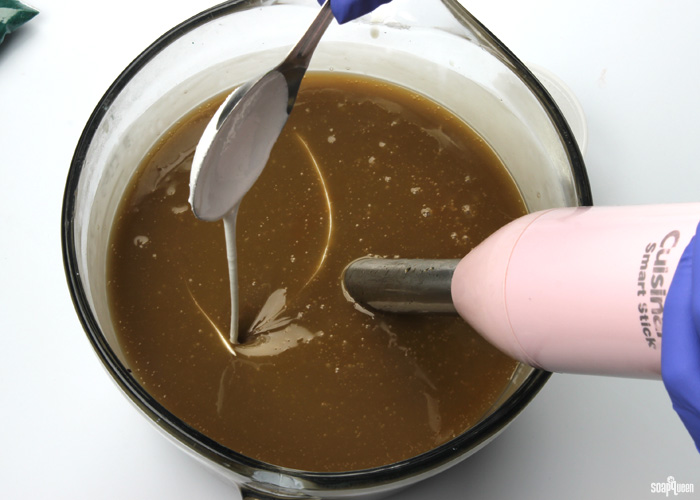
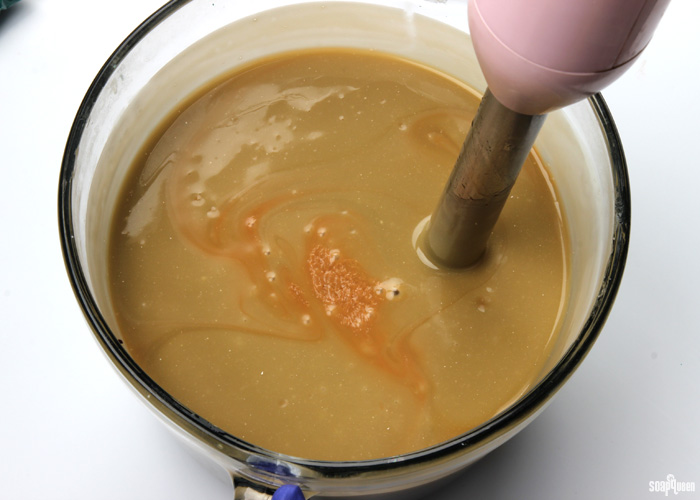
FIVE: Split the batch in half. It’s okay to eyeball it. Each container will hold about 3 cups of soap.
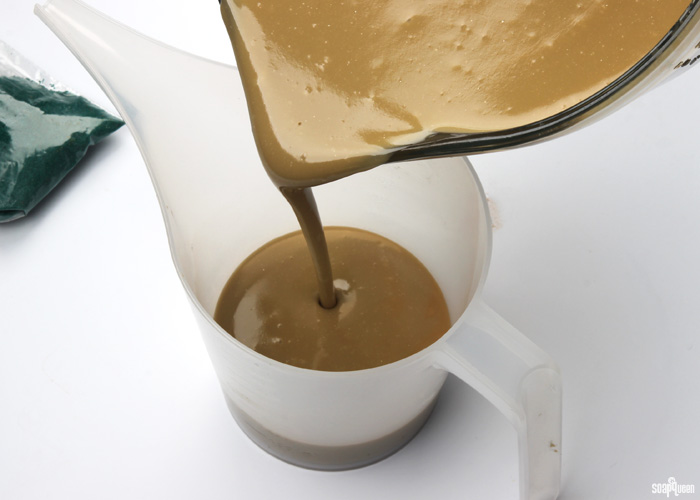 SIX: To one container, add 1 tablespoon dispersed Hydrated Chrome Green Oxide. Use a whisk to fully mix in the colorant.
SIX: To one container, add 1 tablespoon dispersed Hydrated Chrome Green Oxide. Use a whisk to fully mix in the colorant.
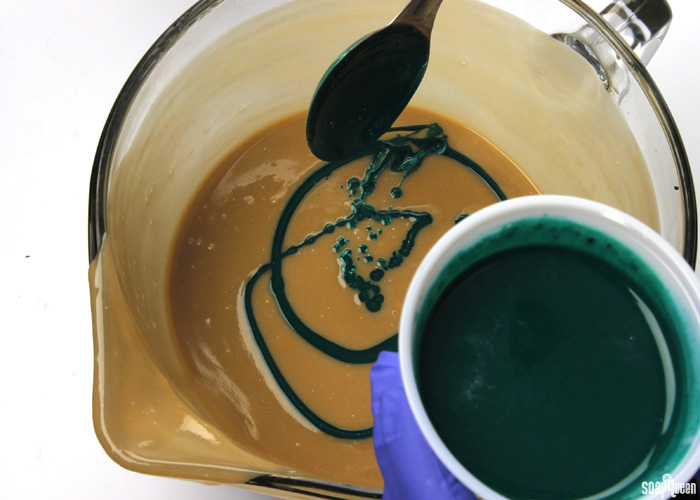
SEVEN: Add half of the Green Tea Fragrance Oil into the green soap mixture, and use the stick blender to fully incorporate the fragrance oil. Continue to stick blend until the soap batter reaches a medium trace. It should be the texture of thick cake batter.
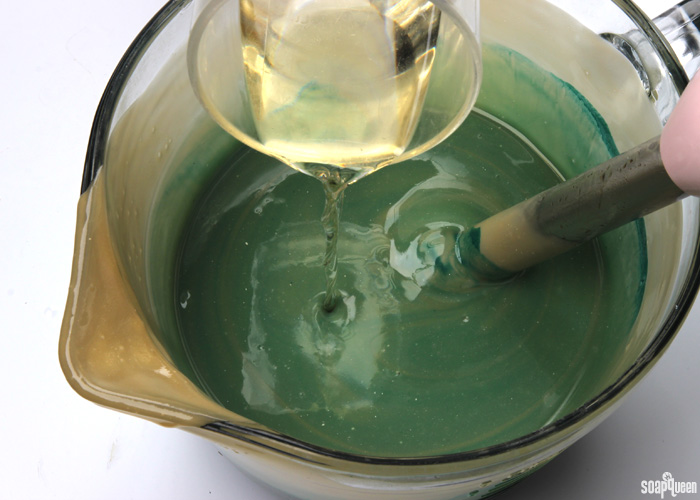 EIGHT: Place the mold onto a large cutting board to help transfer it later. Pour the green soap into the cavities, filling each about halfway. Use the cutting board to tamp the mold onto the counter to help release any air bubbles.
EIGHT: Place the mold onto a large cutting board to help transfer it later. Pour the green soap into the cavities, filling each about halfway. Use the cutting board to tamp the mold onto the counter to help release any air bubbles.
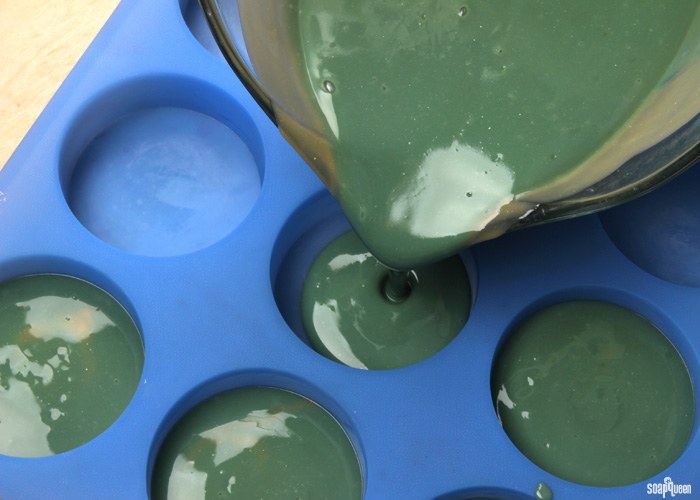 NINE: To the remaining soap, add 1 tablespoon Forest Green Jojoba Beads. Use a whisk to fully mix in the beads.
NINE: To the remaining soap, add 1 tablespoon Forest Green Jojoba Beads. Use a whisk to fully mix in the beads.
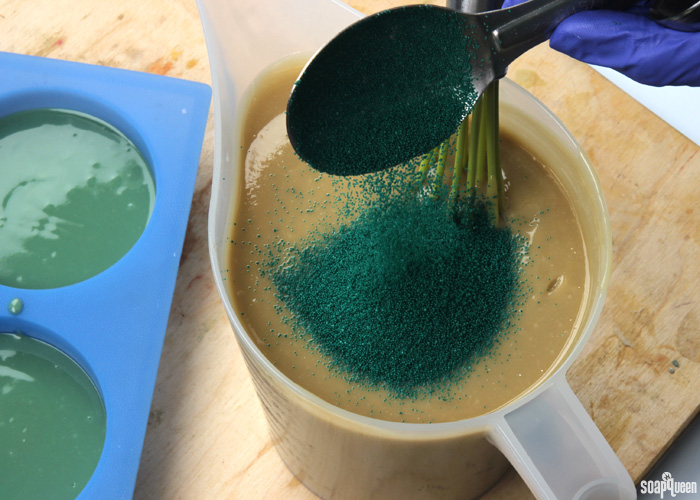
TEN: Mix in the remaining Green Tea Fragrance Oil and use a whisk to fully incorporate the fragrance.
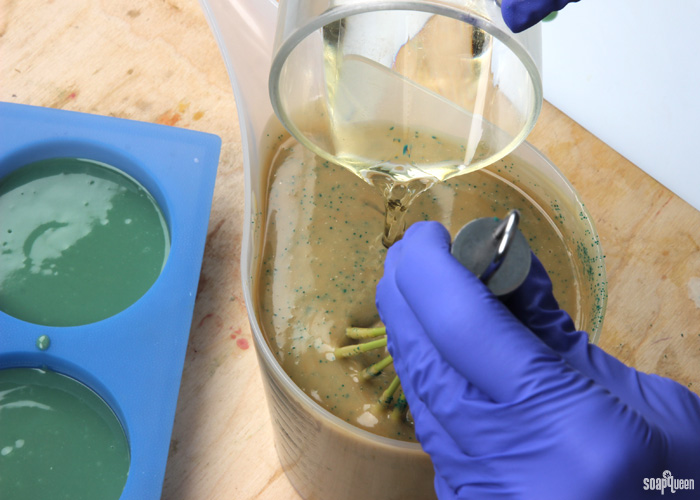
ELEVEN: Slowly and carefully, pour the soap into each cavity, on top of the green layer. Pour gently so you do not break through the green layer below.
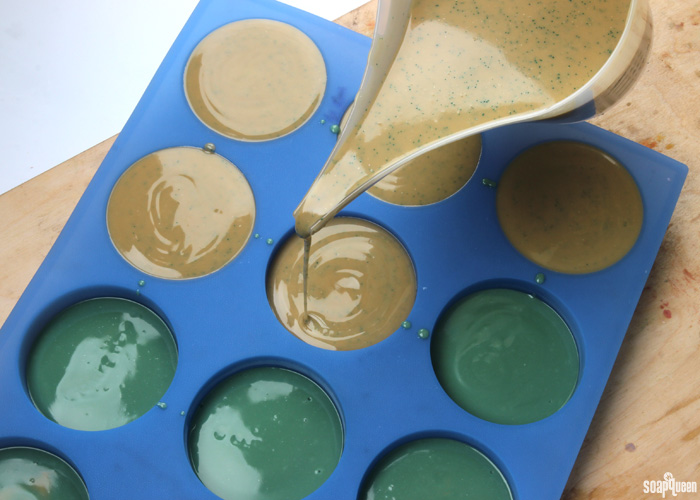
TWELVE: Allow the soap to sit in the mold for several minutes. Once the top layer has thickened, use a spoon to create a gentle swirl. Be careful to not push too far into the soap and disturb the green layer below. Once you’re happy with the swirl, spray the top of the soap with 99% isopropyl alcohol to prevent soda ash. Continue to spray the soap every 15-20 minutes for the first hour. Allow to sit in the mold for 3-4 days and watch the soap lighten up (a lot!). Gently remove the soap and allow to cure for 4-6 weeks.
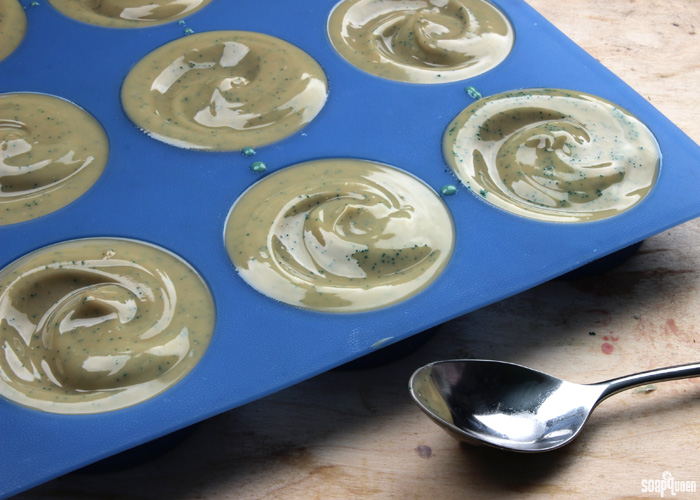
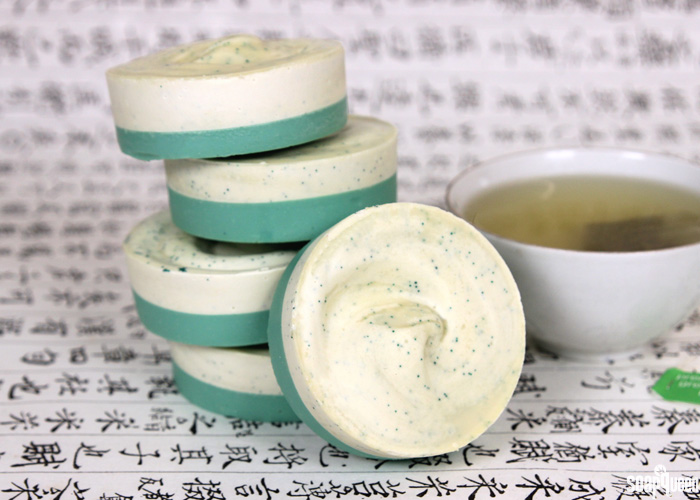 Do you have a favorite alternative liquid that you use in cold process soap?
Do you have a favorite alternative liquid that you use in cold process soap?
- 12 Bar Round Silicone Mold
- 1.8 oz. Avocado Butter
- 2.5 oz. Canola Oil
- 1 oz. Castor Oil
- 8.8 oz. Coconut Oil
- 5.3 oz. Green Tea Seed Oil
- 7 oz. Olive Oil
- 8.8 oz. Palm Oil
- 5 oz. Sodium Hydroxide Lye
- 11.6 oz. Distilled Water
- Hydrated Chrome Green Oxide
- Titanium Dioxide
- Forest Green Jojoba Beads
- 2.5 oz. Green Tea Fragrance Oil
- 1 Tbs. Green Tea Extract
- Optional: Green tea for the lye water
- Slowly and carefully add the lye to the green tea water and gently stir until the lye has fully dissolved. The mixture will be a brown color. Set aside to cool.
- Fully melt the coconut, olive, avocado butter, canola, castor, green tea seed and palm oils (remember to fully melt then mix your entire container of palm oil before portioning). Once the lye water and the oils have cooled to 130 degrees or below (and are ideally within 10 degrees of each other), add the lye water to the oils and stick blend until thin trace. If you’d like a harder bar of soap that releases faster from the mold, you can add sodium lactate to the cooled lye water. Use 1 teaspoon of sodium lactate per pound of oils in the recipe. For this recipe, you’d add about 2 tsp. sodium lactate.
- Once the batter has reached a light trace, add 1 tablespoon Green Tea Extract and stick blend to fully incorporate.
- Add 1 tablespoon dispersed Titanium Dioxide to the entire mixture. Use the stick blender to mix in the colorant, alternating between pulsing and stirring with the blender. As you stick blend, the color will become lighter but will still be a tan color. Don’t worry! The color will continue to lighten as it hardens in the mold.
- Split the batch in half. It’s okay to eyeball it. Each container will hold about 3 cups of soap.
- To one container, add 1 tablespoon dispersed Hydrated Chrome Green Oxide. Use a whisk to fully mix in the colorant.
- Add half of the Green Tea Fragrance Oil into the green soap mixture, and use the stick blender to fully incorporate the fragrance oil. Continue to stick blend until the soap batter reaches a medium trace. It should be the texture of thick cake batter.
- Place the mold onto a large cutting board to help transfer the mold later. Pour the green soap into the cavities, filling each about halfway. Use the cutting board to tamp the mold onto the counter to help release any air bubbles.
- To the remaining soap, add 1 tablespoon Forest Green Jojoba Beads. Use a whisk to fully mix in the beads.
- Mix in the remaining Green Tea Fragrance Oil and use a whisk to fully incorporate the fragrance.
- Slowly and carefully, pour the soap into each cavity, on top of the green layer. Pour gently so you do not break through the green layer below.
- Allow the soap to sit in the mold for several minutes. Once the top layer has thickened, use a spoon to create a gentle swirl. Be careful to not push too far into the soap and disturb the green layer below. Once you’re happy with the swirl, spray the top of the soap with 99% isopropyl alcohol to prevent soda ash. Continue to spray the soap every 15-20 minutes for the first hour. Allow to sit in the mold for 3-4 days. Gently remove the soap and allow to cure for 4-6 weeks.
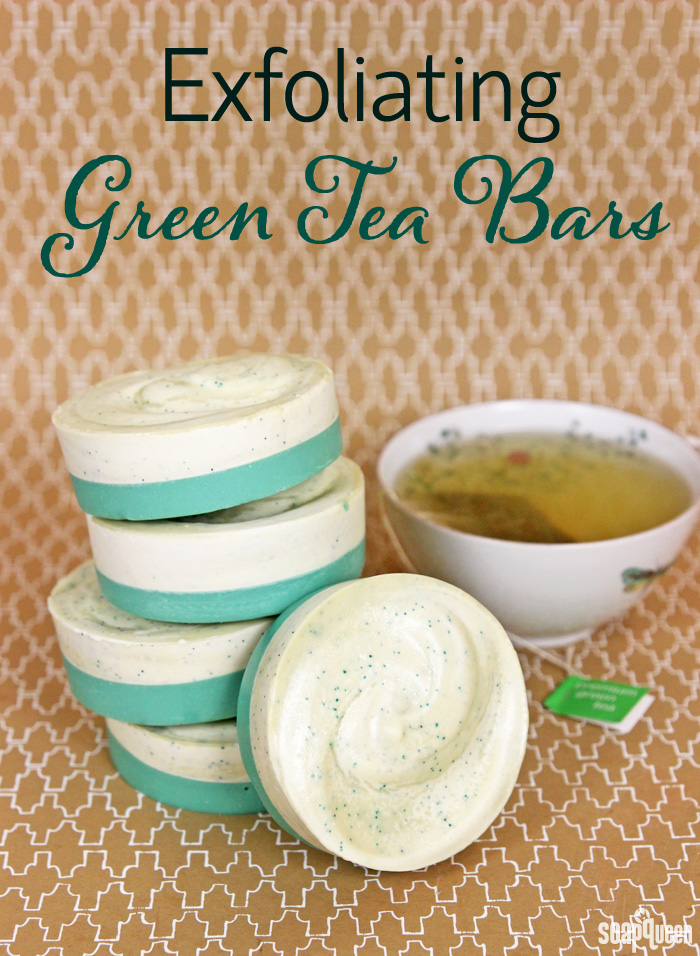
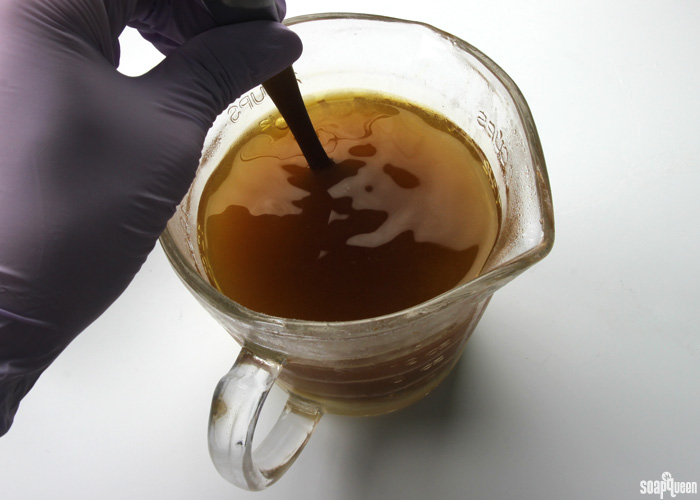


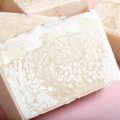
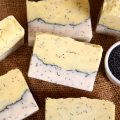

Hello,
I would like to try this recipe. However I do not have any green tea seed oil. Is there some other oil I could substitute and the soap would be as good?
Absolutely! You can use sweet almond, avocado or chia seed oil. They have similar lightweight textures to the green tea seed oil. Just make sure to run your recipe through the Lye Calculator again after any substitutions. 🙂
Lye Calculator: https://www.brambleberry.com/Pages/Lye-Calculator.aspx
Read more about substituting oils in cold process here: http://www.soapqueen.com/bath-and-body-tutorials/tips-and-tricks/how-to-substitute-oil-in-cold-process-recipes/
-Kelsey with Bramble Berry
Thank you so much.
You’re welcome! 🙂
Hello!
I have been a fan of this site for over a year now but have only just dared to venture into CP soap making!
I went on a course to try learn the ‘proper way’ rather than following along to a random YouTube video.
What I have learned and feel quite dissapointed about is that, almost every recipe calls for palm oil. I understand what your stance is (read about it) and even the tutor on the course lectured us on very decent points about using it but I have spoke to many of my friends and relatives and none of them would ever use palm soap. When I have researched replacement oils, tallow and lard seem to be the favourites but again, this doesn’t seem appealing to people. Is it possible to leave them all out and just up the amount of the other oils?
Very sorry for rambling but it is frustrating.
Thank you in advance
Helen
Hi Helen!
I’m sorry about that, I know finding palm replacements can be frustrating. Tallow and lard do add hardness, but there are other ways to firm your bars up! For instance, you can use coconut oil up to 33% and butters like cocoa or shea. They add firming and moisturizing properties to your bars. Read more about butters here: https://www.soapqueen.com/bath-and-body-tutorials/tips-and-tricks/all-about-butters-in-bath-beauty-products/
You can also use sodium lactate. Adding 1 teaspoon of sodium lactate per pound of oils to your cooled lye water helps harden the bars: http://www.soapqueen.com/bramble-berry-news/sunday-night-spotlight-sodium-lactate/
Another option is to make brine bars. The salt solution in the bars makes a nice firm bar that’s ready to unmold quickly: https://www.soapqueen.com/bath-and-body-tutorials/cold-process-soap/brine-and-rose-clay-cold-process-soap-soleseife-soap/
You may also like Anne-Marie’s new book, Pure Soapmaking. The recipes are 50% palm free. 🙂
Pure Soapmaking: https://www.brambleberry.com/Pure-Soap-Making-How-to-Create-Nourishing-Natural-Skin-Care-Soaps-P6298.aspx
-Kelsey with Bramble Berry
Hi from New Zealand!
The only Green Tea extract I can get here is glycerin based. Will this still be ok to use? I REALLY hope so!
Cheers
Jen
Hi Jan!
Glycerin-based extracts may be tricky to incorporate in cold process soap. We’ve found they often create little beads of moisture in the finished bar. They can also cause glycerin rivers: https://www.soapqueen.com/bath-and-body-tutorials/tips-and-tricks/river-runs-deep-explanation-glycerin-rivers/
I would recommend skipping the extract in this recipe. The soap still feels amazing without it, especially with the green tea! 🙂
-Kelsey with Bramble Berry
Okay, thanks but DARN!!!!
HMMMMMM am pondering making some green tea infused oil and Chamomile infused oils to use instead …. Might give that a go!
That would be awesome too! 🙂
This post has more on infusing oils: https://www.soapqueen.com/bath-and-body-tutorials/tips-and-tricks/how-to-infuse-oils-with-a-crock-pot/
-Kelsey with Bramble Berry
Yup – found the tutorial over the weekend! So, I’m going to use Green Tea for the water/lye and Chamomile infused oils. I think that will be fab. Will post a photo on FB when it’s done.
Fantastic, can’t wait to see it! 🙂
-Kelsey with Bramble Berry
Soap has been in mold almost a week and top is hard but green bottom portion still quite soft. Did not uses sodium lactate. Wish I had just placed in my regular loaf mold so would harden faster. They are pretty and smell great. But hate the wait!!
Hi Sherry!
Soap in individual silicone mold cavities do take a little bit longer to unmold, especially without the sodium lactate. My guess is just a few more days will do the trick! You can place the soap into the freezer for a few hours to help the soap harden. This can make it firm enough to remove from the mold if you’re feeling impatient. We certainly do this from time to time! 🙂
-Amanda with Bramble Berry
ooooohhh this looks gorgeous. I don’t know what colour that green bottom half looks like in real life but on my monitor it looks like a beautiful turquoise-green. Reminds me of the ocean – definitely my colour of the moment. 🙂
I made a layered soap like this last week but used matcha powder and yep – it went brown. I need to do it again and follow the philosophy of this formula I think ie tea and MICA.
Round soap. Nice. Thanks. xx
Thank you so much, glad you like the soap! In person the green does definitely have a turquoise look to it. It’s very lovely. Let us know how your next batch goes! 🙂
-Kelsey with Bramble Berry
I absolutely LOVE the tops on these!
Thanks so much Marissa, glad you love the soap! 🙂
-Kelsey with Bramble Berry
More green tea tutorials please.
Thanks for your suggestion Crystal! We’ll keep that in mind for future tutorials. We have a Green Tea Rebatch recipe you may like. 🙂
Green Tea Rebatch: http://www.soapqueen.com/bath-and-body-tutorials/cold-process-soap/green-tea-rebatch-teabatch/
-Kelsey with Bramble Berry
I can’t wait to try this! I ordered the supplies over the weekend with a few changes in mind. I’m going to use distiller water instead of the tea for the lye solution and instead of green tea fragrance oil I’m going to use Pomegranate. Naturally my soaps will be more red but I can’t wait to see how my Pomegranate Tea soap turns out! 🙂
Hi there!
That sounds like a lovely combination! I love the smell of pomegranate. Let us know how it goes! 🙂
-Kelsey with Bramble Berry
Hi!
So I was wondering how soft would a bar of soap be if it was 100% olive oil with a 10% superfat. Would it be ridiculously to soft? If not, would it be an ultra gentle baby bar? I am just curious.
Thank you!
Hi Emmeline!
A 100% olive oil soap with 10% superfat would be very, very soft. Because olive oil is liquid at room temperature, it makes a softer bar. Also, 10% superfat would leave lots of freefloating oils, contributing to an extra soft bar.
Castile soap (or 100% olive oil soap) can take several weeks to remove from the mold, and six months or more to fully harden and cure. The good news is it would be very gentle and soothing! Read more in the Castile Soap Tutorial: http://www.soapqueen.com/bramble-berry-news/olive-oil/
If you wanted to harden that bar up a bit, you can water discount the soap 10% or more. You can also add 1 tsp. of sodium lactate per pound of oils to your cooled lye water. Read more in the Sunday Night Spotlight: Sodium Lactate post: http://www.soapqueen.com/bramble-berry-news/sunday-night-spotlight-sodium-lactate/
You can also add a hard oil, like coconut oil, for some firmness. Coconut oil was added to the Buttermilk Baby Bastile Bar, and it’s still nice and gentle: http://www.soapqueen.com/bath-and-body-tutorials/cold-process-soap/buttermilk-bastille-baby-bar-on-soap-queen-tv/
-Kelsey with Bramble Berry
Do you recommend anything to use in place of the green tea seed oil? Would it make much of a difference? It is a little pricey! Can’t wait to try this though
Hi Christine!
So glad you’re going to give the recipe a try! Any lightweight oil would work as a substitute for green tea seed oil. Some options include sweet almond oil, chia seed oil or meadowfoam oil. Remember to run your recipe through the Lye Calculator again after making any substitutions!
Lye Calculator: https://www.brambleberry.com/Pages/Lye-Calculator.aspx
This post on How to Substitute Oil in Cold Process Recipes may be helpful for you as well: http://www.soapqueen.com/bath-and-body-tutorials/tips-and-tricks/how-to-substitute-oil-in-cold-process-recipes/
-Kelsey with Bramble Berry
Sweet almond oil: https://www.brambleberry.com/Sweet-Almond-Oil-P3205.aspx
Chia seed oil: https://www.brambleberry.com/Chia-Seed-Oil-P5612.aspx
Meadowfoam oil: https://www.brambleberry.com/Meadowfoam-Oil–P4978.aspx
I really like those! A couple of weeks ago, when I placed my last order, Green Tea Extract was out of stock, so I didn’t get it. Otherwise, I would make that one right away!
I have all the others though. 🙂
So glad you like the bars Martina! Good news – the green tea extract is back in stock now. 🙂
Green tea extract: https://www.brambleberry.com/Green-Tea-Extract–P4929.aspx
Also, any extract would work well in this recipe! Aloe extract would add some moisturizing properties and would feel great. Oat extract would feel great too. Read more in the Sunday Night Spotlight: Extracts post: http://www.soapqueen.com/bramble-berry-news/sunday-night-spotligh-extracts/
-Kelsey with Bramble Berry
Love how the soap looks. Will the soap eventually turn brown because of the green tea or will it remain light in color?
So glad you love the soap Marleny! I’m not exactly sure if the tea will darken over time. I would imagine there is a possibility. However, we have bars made with tea that haven’t discolored. Some of them were made up to a year ago. 🙂
-Kelsey with Bramble Berry
I hesitate to use Green Tea for soaping…the one & only time I used it, the soap never lighted up, but stayed a dark beige – like in the photo’s above when pouring the top half.
Anyone else out there that has used Green Tea and had any other experiences?
Other than that, I think this looks like a really yummy recipe!
Thank you!!
Hi Sly!
When we added the green tea and lye to the oils, the soap stayed fairly dark, even with Titanium Dioxide added. However, we noticed the bars lightened up quite a bit as they saponified. We made another batch before this one and it turned white as well.
It will definitely depend on the tea though! Some brands may be darker than others. If you like, you can also add fewer tea bags, or not let it steep as long. That may help lighten those colors up for you. 🙂
You could also work with the discoloration, and create a darker color palette. That would look lovely as well!
-Kelsey with Bramble Berry
How many tea bags did you use in this recipe?
These bars look awesome! So pleasing to the eye. Thanks for the pictures too. I’ve never made soap with Green Tea and it is nice to see what it looks like with the lye and then how light it gets in the finished bar! Descriptions are useful, but I find pictures are way better!
So glad you like the bars Margaret! Thanks so much for your kind message. Also, I agree – having pictures is so helpful, especially if you’re a more visual learner. 🙂
-Kelsey with Bramble berry